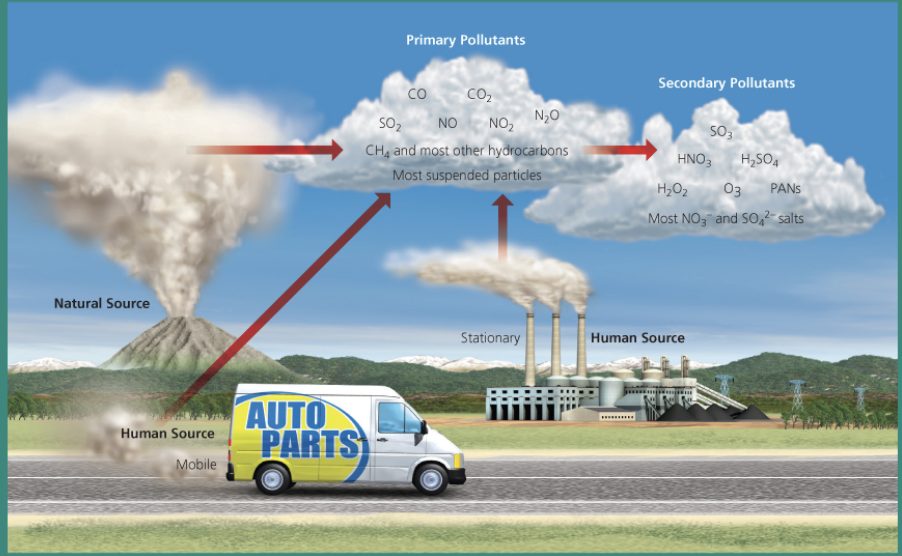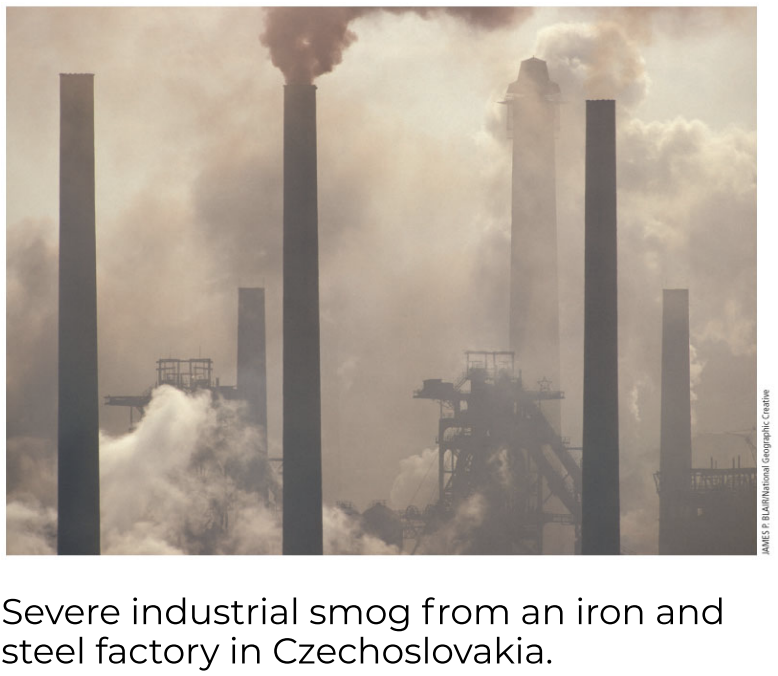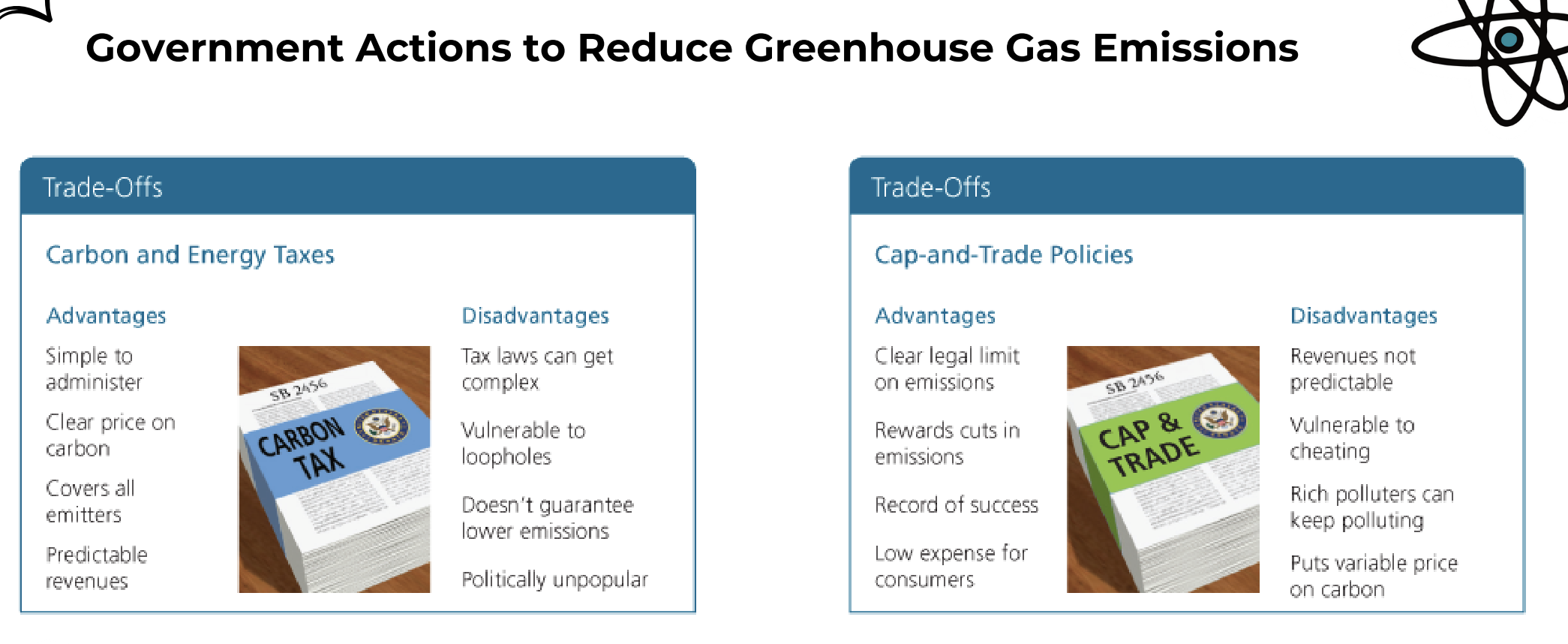Chapter 15 -Environmental Science
1/50
Earn XP
Description and Tags
Air Pollution, Climate Change, and Ozone Depletion
Name | Mastery | Learn | Test | Matching | Spaced |
|---|
No study sessions yet.
51 Terms
Atmospheric warming
Atmospheric warming is the gradual rise in the average temperature of the atmosphere near the earth’s surface over 30 years or more.
Climate Change
climate change—measurable changes in global weather patterns based primarily on changes in the earth’s atmospheric temperature averaged over at least 30 years.
If climate change melted all of Greenland’s ice, how much might sea level rise?
23 ft.
3 major conclusions about climate change:
it is real and is happening now,
human activities such as the burning of fossil fuels and the clearing of forests play an important role in current climate change, and
it is projected to accelerate and have harmful effects, such as rising seas, ocean acidification, species extinction, and more extreme weather, including more intense and longer lasting heat waves, unless we act now to slow it down.
What Is the Nature of the Atmosphere?
The two innermost layers of the atmosphere are the troposphere, which supports life, and the stratosphere, which contains the protective ozone layer.
The Atmosphere Consists of Several Layers
The atmosphere is composed of several spherical layers:
The layer of air directly above the surface is the troposphere, which supports life.
The layer above this is the stratosphere, which contains the earth’s protective ozone layer.

Troposphere
The troposphere contains the air we breathe and is composed mainly of nitrogen and oxygen—but also contains greenhouse gasses (H2O, CO2, CH4, N2O).
Stratosphere
The stratosphere is similar in composition to the troposphere, but has much less water vapor and contains the ozone layer.
Ozone Layer
Layer of gaseous ozone (O3) in the stratosphere that protects life on earth by filtering out most harmful ultraviolet radiation from the sun.
Air pollution
Air pollution is the presence of chemicals in the atmosphere in concentrations high enough to harm organisms, ecosystems, or human-made materials, or to alter climate.
Air pollutants come from natural and human sources.
Natural sources include wind-blown dust, solid and gaseous pollutants from wildfires and volcanic eruptions, and volatile organic chemicals released by some plants.
Human sources are mostly generated by the burning of fossil fuels, industrial facilities, and motor vehicles.
Primary pollutants
Primary pollutants are chemicals or substances emitted directly into the air from natural processes and human activities at concentrations high enough to cause harm.

Secondary pollutants
Secondary pollutants are formed when primary pollutants react with one another and with other natural components of air to form new harmful chemicals.

Major Outdoor Air Pollutants
Carbon Oxides
Carbon monoxide
Carbon dioxide
Nitrogen Oxides and Nitric Acid
Sulfur Dioxide and Sulfuric Acid
Particulates
Suspended particulate matter
Ozone (O )3
Volatile Organic Compounds (VOCs)
Industrial smog
Industrial smog is a type of air pollution consisting mostly of a mixture of sulfur dioxide, suspended droplets of sulfuric acid formed from some of the sulfur dioxide, and suspended solid particles.

Photochemical smog
Photochemical smog is a mixture of primary and secondary pollutants formed under the influence of UV radiation from the sun.

Factors that increase air pollution:
Urban buildings slow wind speed and reduce the dilution and removal of pollutants.
Hills and mountains reduce the flow of air in valleys below them and allow pollutant levels to
build up at ground level.
High temperatures promote the chemical reactions leading to the formation of photochemical
smog.
Emissions of VOCs from certain trees and plants in urban areas can promote the formation of
photochemical smog.
Air pollution can move from one country to another
Temperature inversion
Temperature inversion
Occurs when a layer of dense, cool air trapped under a layer of less dense, warm air. It prevents upward-flowing air currents from developing. In a prolonged inversion, air pollution in the trapped layer may build up to harmful levels.
Factors that help reduce air pollution:
First, particles heavier than air settle out of the atmosphere.
Second, rain and snow partially cleanse the air of pollutants.
Third, salty sea spray from the oceans washes out many pollutants from air that flows from land over the oceans.
Fourth, winds sweep pollutants away and dilute them by mixing them with cleaner air.
Fifth, some pollutants are removed by chemical reactions.
Acid deposition (acid rain)
Acid deposition (acid rain) is the falling of acid and acid-forming compounds from the atmosphere to the earth’s surface.
Wet deposition: acid rain/snow/cloud vapor; happens slowly in distant downwind areas
Dry deposition: acidic particles; happens quickly close to industrial sources
Acid Deposition: Problems and Solutions
Acid deposition
harms crops,
reduces plant productivity,
leaches essential nutrients from soil,
damages buildings,
contributes to human respiratory disease,
and leaches toxic metals into the environment that get biomagnified into food webs

Indoor Air Pollution
In less-developed countries, indoor air pollution mainly comes from indoor burning of wood, charcoal, dung, and coal in open fires/poorly vented stoves

Air Pollution Affects Your Health

Ways to Strengthen Laws and Regulations
Environmental scientists applaud this important success, but they call for strengthening U.S. air pollution laws by:
Putting much greater emphasis on air pollution prevention.
Sharply reducing emissions from older coal-burning power and industrial plants, cement plants, oil refineries, and waste incinerators.
Reducing atmospheric emissions of toxic pollutants such as mercury.
Continuing to improve fuel efficiency standards for motor vehicles.
Stricter regulation of emissions from motorcycles and two-cycle gasoline engines.
Setting much stricter air pollution regulations for airports and oceangoing ships.
Sharply reducing indoor air pollution.
Using the Marketplace to Reduce Outdoor Air Pollution
In a cap-and-trade program, the government sets an emissions cap and issues a quantity of emission allowances consistent with that cap.
Companies may buy and sell allowances, and this market establishes an emissions price.
The ultimate success of any emissions trading approach depends on two factors:
how low the initial cap is set
and how often it is lowered to promote continuing innovation in air pollution prevention and control.

Other Ways to Reduce Outdoor Air Pollution

Reducing Indoor Air Pollution
Less effort has been devoted to reducing indoor air pollution even though it poses a much greater threat to human health than does outdoor air pollution.

Reminder: Weather and Climate Are Not the Same
Weather consists of short-term changes in atmospheric variables such as the temperature and precipitation in a given area over a period of hours or days.
Climate is determined by the average weather conditions of the earth or a particular area, especially atmospheric temperature, over at least three decades.
Atmospheric warming does not mean that all areas of the earth are getting warmer.
Instead, as the earth’s average atmospheric temperature rises, some areas get warmer and some get cooler because of interactions in the planet’s complex climate system.
How Do We Know Climate Change is Happening?
Scientists estimate past temperature changes by analyzing evidence from many sources. They include
radioisotopes in rocks and fossils;
plankton and radioisotopes in ocean sediments;
tiny bubbles, layers of soot, and other materials trapped in different layers of ancient air found in ice cores from glaciers;
pollen from the bottoms of lakes and bogs;
tree rings;
and atmospheric temperature measurements taken regularly since 1861.
Greenhouse Effect
The greenhouse effect is a natural process that plays a major role in determining the earth’s average atmospheric temperature and thus its climate.
Greenhouse gases include
carbon dioxide, methane, nitrous oxide, and water vapor
The atmospheric concentration of CO2, as part of the carbon cycle, plays a key role in determining the average temperature of the atmosphere.
Carbon footprint
Carbon footprint - the amount of carbon dioxide generated by an individual, an organization, or a geographically or politically defined area (such as a city, state, or country) in a given period of time.
Per Capita Carbon footprint
Per Capita Carbon footprint - average carbon footprint per person in a population. Compare carbon footprint.
How the Earth Effects Current Atmospheric Warming
The Oceans
Research indicates that the oceans remove roughly 25% of the CO2 pumped into the lower atmosphere by human activities.
The oceans also absorb heat from the lower atmosphere.
The Atmosphere
An increase in thick and continuous cumulus clouds at low altitudes would have a cooling effect by reflecting more sunlight back into space.
An increase in thin, wispy cirrus clouds at high altitudes would warm the lower atmosphere by allowing more sunlight to reach the earth’s surface and preventing some heat from escaping into space.
Rapid Atmospheric Warming Could Have Serious Consequences
Climate research and worst-case climate model projections indicate that rising atmospheric temperatures will likely lead to the following effects within this century:
floods in low-lying coastal cities from a rise in sea levels (see chapter-opening photo)
more severe drought
more intense and longer-lasting heat waves
more destructive storms and flooding
forest loss and increased forest fires
species extinction
changes in where we can grow food
Scientists have identified several components of the earth’s climate system that could exceed climate change tipping points—thresholds beyond which climate change could last for hundreds to thousands of years.

Increased Melting of Ice, Snow and Permafrost
Light-colored ice and snow in polar regions helps to cool the earth by reflecting incoming solar energy back into space (albedo effect).
Melting ice and snow will expose darker land and sea surfaces which reflect less sunlight and absorb more solar energy—this warms the atmosphere.
Methane Emissions from Thawing Permafrost
If the current melting trend of permafrost continues, the organic material stored below the permafrost layer would most likely rot and release large amounts of CH4 and CO2 into the atmosphere, accelerating atmospheric warming—setting up a positive feedback loop.
Rising Sea Levels
Good news: The world’s oceans have helped slow climate change by absorbing about 90% of the extra heat added to the atmosphere as a result of increased emissions of greenhouse gases from the burning of fossil fuels and other human activities.
Bad news: As the oceans store more heat they expand. This, along with water flowing into the ocean from melting land-based glaciers, raises the world’s average sea level.
Effects of Rising Sea Levels
Degradation or destruction of at least one-third of the world’s coastal estuaries, wetlands, coral reefs, and deltas where much of the world’s rice is grown.
Disruption of many of the world’s coastal fisheries.
Saltwater contamination of freshwater coastal aquifers resulting in degraded supplies of groundwater used for drinking and irrigation.
Flooding in large areas of low-lying countries such as Bangladesh, one of the world’s poorest and most densely populated nations.
Flooding and erosion of low-lying barrier islands and gently sloping coastlines, especially in U.S. coastal states such as Florida, Texas, Louisiana, New Jersey, South Carolina, and North Carolina.
Flooding of some of the world’s largest coastal cities.
Submersion of low-lying island nations such as the Maldives and Fiji.
Extreme Weather Will Become More Common
Some regions will experience increased chance of extreme drought, more intense heat waves, and expansion of deserts.
Prolonged drought can decrease the growth of trees and other plants, which decreases their removal of CO2 from the atmosphere. It also dries out forests and grasslands, which can increase the frequency of wildfires that add to the atmosphere.
Other regions will experience increased flooding, precipitation (snow, rain), stronger hurricanes and typhoons, and colder winters
Threats to Biodiversity
As the atmosphere warms, at least 17% of the world’s species could face extinction by 2100.
The hardest hit species will be
Cold-climate plant and animal species, including the polar bear and walruses in the Arctic and penguins in Antarctica.
Species that live at higher elevations.
Species with limited ranges.
Species with limited tolerance for temperature change, such as corals.
Threats to Food Production
Higher temperatures, more intense droughts and heavier downpours could reduce crop yields in some farming areas.
Shrinking irrigation water supplies and growing pest populations in a warmer world could also cut crop yields in some areas.
Climate change models project a decline in agricultural productivity and food security in tropical and subtropical regions, especially in Southeast Asia and Central America, largely because excessive heat.
Threats to Human Health, National Security, and Economies
More frequent and prolonged heat waves could increase illnesses and the death rate.
With a warmer, more CO2-rich atmosphere, disease-transmitting insects, microbes, and mold populations will multiply.
Heavy photochemical smog will cause pollution-related respiratory problems and often death.
Failure to slow and adapt to climate change tops the list of threats to the global economy.
How Can We Slow Climate Change?
We can reduce greenhouse gas emissions and the threat of climate change while saving money and improving human health if we cut energy waste and rely more on cleaner renewable energy resources.
Mitigation
preventing or reducing the emission of greenhouse gases (GHG) into the atmosphere to make the impacts of climate change less severe
Adaptation
anticipating the adverse effects of climate change and taking appropriate action to prevent or minimise the damage they can cause, or taking advantage of opportunities that may arise
Reducing Greenhouse Gas Emissions
Shifting our dependence on fossil fuels to renewable energy sources will help humanity avoid exceeding the temperature climate tipping point (a rise of no more than 2°C by 2050).

Carbon capture storage
Carbon capture storage - Process of removing carbon dioxide gas from coal- burning power and industrial plants and storing it somewhere (usually underground or under the seabed).
Major problems with CCS schemes include
they can remove and store only part of the CO2 from smokestack emissions, at great cost,
they do not address the massive emissions from motor vehicle exhausts, food production, and the deliberate burning of forests to provide land for growing food,
they require a lot of energy
the CO2 that is removed would have to remain sequestered from the atmosphere forever.
Government Actions to Reduce Greenhouse Gas Emissions
Strictly regulate CO2 and CH4
Phase out coal-burning power plants
Tax CO2 or CH4 emissions/start energy taxes
Use a cap-and-trade system
Phase out subsidies/tax breaks for fossil fuel industries and industrialized food production
Offer subsidies for energy efficient technologies
Increase development of alternatives
Some countries, states, cities, and private companies are working to reduce their carbon footprints
Colleges and universities also reducing carbon footprints
We can prepare for climate change

Preparing for Climate Change
Because of the political difficulty of making such large reductions, many analysts believe that while we work to slash greenhouse gas emissions, we should also prepare for the likely harmful effects of projected climate change.
The Use of Certain Chemicals Threatens the Ozone Layer
The ozone in the stratosphere keeps about 95% of the sun’s harmful ultraviolet (UV-A and UV-B) radiation from reaching the earth’s surface and harming us and many other species.
Ozone thinning stems from the overuse of harmful chlorofluorocarbons (CFCs) known as Freons—used for coolants/air conditioning

Big Ideas
We need to give top priority to preventing and reducing outdoor and indoor air pollution and reducing stratospheric ozone depletion.
Reducing the projected harmful effects of rapid climate change during this century requires emergency action to sharply reduce greenhouse gas emissions, increase energy efficiency, and rely more on low-carbon renewable energy resources.
We can prepare for some climate change but we could realize important economic, ecological, and health benefits by drastically reducing greenhouse gas emissions with the goal of slowing climate change.